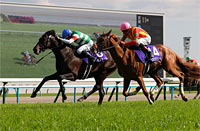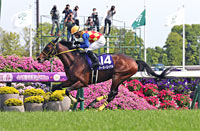Tenno Sho (Spring) (G1) - Data Analysis
Legend of a new “strongest stayer” is about to begin
As the longest race in domestic Grade 1 flat racing, the Tenno Sho (Spring) is duly regarded as deciding Japan’s “strongest stayer.” Over the last eight years since 2009, horses in “Bracket No.1” have won this race five times; of these eight winners, Meiner Kitz in 2009 was billed as 12th favorite, Hiruno d’Amour in 2011 as 7th favorite, and Beat Black in 2012 as 14th favorite. In 2015, meanwhile, the 10th favorite Curren Mirotic finished 3rd. In other words, “unfavored horses in bracket No. 1” have had their fair share of success in this race. So which of this year’s runners will take the title of “strongest stayer”? Let’s analyze results over the last 10 years to find some clues.
Check favoritism in the previous year’s final outing
First, let’s aggregate the performances of runners over the last 10 years in terms of their favoritism to win their final outing in the previous year. When this “final outing” was a domestic race, only horses backed as “1st-4th favorite” in that race have won the Tenno Sho (Spring). The poorest success ratios in this regard belong to the “6th-9th favorite” and “10th favorite or lower” groups – another indication that runners backed among the higher favorites in their final outing of the previous year should be given serious attention in this race. [Table 1]
[Table 1] Performance by favoritism in previous year's final outing (last 10 years)
| Favoritism |
Performance
[1st-2nd-3rd-4th or lower] |
Win ratio |
Top 2 ratio |
Top 3 ratio |
| 1st favorite |
3-3-1-15 |
13.6% |
27.3% |
31.8% |
| 2nd favorite |
1-1-2-14 |
5.6% |
11.1% |
22.2% |
| 3rd favorite |
2-1-0-17 |
10.0% |
15.0% |
15.0% |
| 4th favorite |
3-1-1-15 |
15.0% |
20.0% |
25.0% |
| 5th favorite |
0-2-0-8 |
0% |
20.0% |
20.0% |
| 6th-9th favorite |
0-0-3-34 |
0% |
0% |
8.1% |
| 10th favorite or lower |
0-2-1-32 |
0% |
5.7% |
8.6% |
| Overseas races |
1-0-2-8 |
9.1% |
9.1% |
27.3% |
Front runners in the ascendancy
When looking at the most previous performances of all runners in the past 10 years, each of the last 10 winners had most recently contested in a JRA race and had been positioned “6th or higher” at the 4th corner in that race. Conversely, those positioned “7th or lower” at the 4th corner in a JRA race last time out have only achieved a Top 3 ratio of 11.1%, while the “Leader” and horses positioned “2nd-6th” have amassed ratios in excess of 20%. As this would suggest, runners positioned near the front at the 4th corner in their previous outing are in the ascendancy here. It might be interesting to take a good look at runners most recently involved in JRA races and their positions as they rounded the 4th corner in that race. [Table 2]
[Table 2] Performance by position at the 4th corner last time out (last 10 years)
| Position at 4th corner last time out |
Performance
[1st-2nd-3rd-4th or lower] |
Win ratio |
Top 2 ratio |
Top 3 ratio |
| Leader |
1-2-0-11 |
7.1% |
21.4% |
21.4% |
| 2nd-6th |
9-4-6-73 |
9.8% |
14.1% |
20.7% |
| 7th or lower |
0-4-3-56 |
0% |
6.3% |
11.1% |
| Last race was overseas |
0-0-1-3 |
0% |
0% |
25.0% |
1st favorite not doing so well
In aggregate performances based on favoritism over the last 10 years, the “2nd favorite” and “3rd favorite” have achieved Top 3 ratios of 70.0% and 60.0%, respectively. By contrast, the “1st favorite” has struggled, with no Top 2 finishes and a Top 3 ratio of only 10.0%. On the other hand, the “6th-9th favorite” and “10th favorite or lower” groups, though only managing Top 3 ratios of less than 10%, have produced a total of 10 Top 3 finishes. What’s more, a horse backed as “6th favorite or lower” has finished in the Top 3 for eight straight years since 2009. It will be very interesting to see if the favorite can actually win this year, for the first time since Deep Impact in 2006. [Table 3]
[Table 3] Performance by favoritism (last 10 years)
| Favoritism |
Performance
[1st-2nd-3rd-4th or lower] |
Win ratio |
Top 2 ratio |
Top 3 ratio |
| 1st favorite |
0-0-1-9 |
0% |
0% |
10.0% |
| 2nd favorite |
5-1-1-3 |
50.0% |
60.0% |
70.0% |
| 3rd favorite |
1-4-1-4 |
10.0% |
50.0% |
60.0% |
| 4th favorite |
1-2-1-6 |
10.0% |
30.0% |
40.0% |
| 5th favorite |
0-0-2-8 |
0% |
0% |
20.0% |
| 6th-9th favorite |
1-1-1-37 |
2.5% |
5.0% |
7.5% |
| 10th favorite or lower |
2-2-3-76 |
2.4% |
4.8% |
8.4% |
Check the recent record in long-distance racing
Next, let’s look at aggregate performances by runners over the last 10 years in terms of their lowest finish in turf races over distances of 2,400m or more within their last three outings. Here, the two groups with lowest finishes of “2nd” and “5th” have both amassed Top 3 ratios in excess of 30%. Nine of the runners in that time had never finished below “1st” in such races, but they have fared poorly here; none of them has won this race, and only one has finished in the Top 3. The groups with the best Win ratios are those with lowest finishes of “2nd,” “3rd” and “5th.” It might be a good idea to check how the runners finished in recently contested long-distance races. [Table 4]
[Table 4] Performance by lowest finish in turf races over 2,400m+ within the last three outings (last 10 years)
| Lowest finish |
Performance
[1st-2nd-3rd-4th or lower] |
Win ratio |
Top 2 ratio |
Top 3 ratio |
| 1st |
0-1-0-8 |
0% |
11.1% |
11.1% |
| 2nd |
2-1-2-9 |
14.3% |
21.4% |
35.7% |
| 3rd |
2-0-1-15 |
11.1% |
11.1% |
16.7% |
| 4th |
1-0-1-12 |
7.1% |
7.1% |
14.3% |
| 5th |
3-2-2-14 |
14.3% |
23.8% |
33.3% |
| 6th-9th |
1-3-1-40 |
2.2% |
8.9% |
11.1% |
| 10th or lower |
1-2-2-38 |
2.3% |
7.0% |
11.6% |
| No such race entered |
0-1-1-7 |
0% |
11.1% |
22.2% |
Seek out the winner!
Also check the recent record in long-distance graded races
All four winners of this race since 2013 had experienced wins in turf graded races over distances of 2,500m or more within their last three outings. When attempting to predict the winner, we should be looking for runners with this kind of experience in recent long-distance graded races. [Table 5]
[Table 5] Performance by highest finish in turf graded races over 2,500m+ within the last three outings (last 4 years)
| Highest finish |
Winner |
2nd or lower |
| 1st |
4 |
14 |
| 2nd or lower, or no such race entered |
0 |
53 |
(Michio Kawano)
|



















